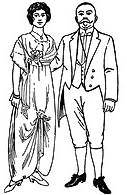Knock, Knock. . . Who Lives Here?
In March 2010, the 23rd U.S. census went out—220 years after the first census, in 1790. What do census questions tell us about American society and values? Look at the categories of census data below and select the year in which the information was collected.
1. 1790
families with 11 or more members
families holding 2-4 slaves
avg. slaves per slaveholding family
free colored slaveholding families
persons of Scotch nationality
persons of Hebrew nationality
2. 1840
white persons 20 years of age and over who cannot read and write
scholars in primary and common schools
female slaves 55-99 years of age
free colored females under 10 years of age
men employed in newspaper production
persons employed in navigation of canals
3. 1870
male citizens 21 years of age and over
persons born in Africa
persons 10 and over who cannot read
total state taxation
public debt of the county
youths employed in manufacturing
4. 1880
persons born in China
Indians
colored persons
farms 500-999 acres rented for fixed money rental
average hours labor per week in iron and steel manufacturing
average youths and children employed in manufacturing
5. 1900
other colored females 5-20 years of age
illiterate foreign-born alien males 21 years of age and over
native white illiterates 10 years of age and over of native parentage
farms of colored owners and tenants
capital invested in buildings used in manufacturing
salaries of salaried officials, clerks, etc. in manufacturing
6. 1910
rural population
white persons born in asian turkey
native white males of voting age of mixed parentage
Indian, Chinese, Japanese and male of all other races of voting age
persons 15-17 years of age attending school
farms of foreign-born whites
 In 1790, federal marshals collected data for the first census, knocking by hand on each and every door. As directed by the U.S. Constitution, they counted the population based on specific criteria, including "males under 16 years, free White females, all other free persons (by sex and color), and slaves." There was no pre-printed form, however, so marshals submitted their returns, sometimes with additional information, in a variety of formats.
In 1790, federal marshals collected data for the first census, knocking by hand on each and every door. As directed by the U.S. Constitution, they counted the population based on specific criteria, including "males under 16 years, free White females, all other free persons (by sex and color), and slaves." There was no pre-printed form, however, so marshals submitted their returns, sometimes with additional information, in a variety of formats.
In 1810 and 1820, additional categories appeared, collecting information on "free White males and females under 10 years of age," as well as those "10 and under 16," "16 and under 26," "26 and under 45," and "45 years and upward." "Free colored persons" and slaves were now counted separately as were "all other persons, except Indians not taxed" and "foreigners not naturalized." Through the decades, the census continued to expand, including a growing number of questions on agriculture, manufacturing, living conditions, education, crime, mortality, and increasingly, race and ancestry.
The census has always had political implications, informing conscription, Congressional representation, and the collection and allocation of taxes. It has also always both reflected and shaped social divisions. Before 1960, census enumerators interviewed families in person and without consulting the individuals, selected which box to check for "race." Starting in 1960, largely for financial reasons, the Census Bureau mailed forms directly to households, thereby allowing individuals to select their own boxes. This led to a fundamental change in the way race was categorized and measured. In 2000, for the first time, individuals could select more than one box and about 6.8 million Americans did so, reflecting the complex nature of racial and ethnic categories today.
The 2010 census is designed to count all residents and will ask a small number of questions, such as name, sex, age, date of birth, race, ethnicity, relationship and housing tenure. The longer American Community Survey will collect socioeconomic data annually from a representative sample of the population.
For searchable (and map-able) databases of historical census data from 1790 to 1960, refer to the University of Virginia's United States Historical Census Data Browser. For more current information, try the official website of the U.S. Census Bureau..
- PBS, Race, the Power of an Illusion (accessed December 2, 2009).
- U.S. Census Bureau, "History" (accessed December 2, 2009).
- U.S. Census Bureau, "Measuring America: The Decennial Censuses from 1790 to 2000" (accessed December 2, 2009).
- U.S. Census Bureau, "Selected Historical Decennial Census Population and Housing Counts" (accessed December 2, 2009).
- University of Virginia, Geospatial and Statistical Data Center, Historical Census Browser (accessed December 2, 2009).
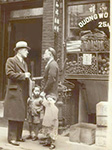
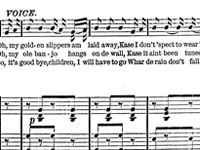
 1915
1915 1925
1925 1917 (Note the military accents.)
1917 (Note the military accents.) 1905.
1905. 1935.
1935. 1910.
1910. 1940.
1940. 1895.
1895. 1955.
1955. 1960.
1960.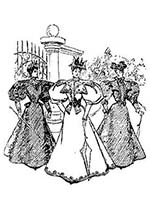
 [Question 1] The first photograph of either a president or a first lady broadcasting from the White House is of Mrs. Hoover. She began national broadcasts in 1929, even setting up a practice room in the White House where she could "improve [her] talkie technique." Many of her broadcasts were made from President Hoover's country retreat, Camp Rapidan, where she often devoted her programs to speaking to young people, urging girls to contemplate independent careers and boys to help with the housework. Mrs. Hoover had a degree in geology from Stanford University, as did her husband. She had accompanied him to China for two years, where he hadsupervised the country's mining projects. She later used the Mandarin Chinese she learned then to communicate with her husband privately when they were in the presence of others.
[Question 1] The first photograph of either a president or a first lady broadcasting from the White House is of Mrs. Hoover. She began national broadcasts in 1929, even setting up a practice room in the White House where she could "improve [her] talkie technique." Many of her broadcasts were made from President Hoover's country retreat, Camp Rapidan, where she often devoted her programs to speaking to young people, urging girls to contemplate independent careers and boys to help with the housework. Mrs. Hoover had a degree in geology from Stanford University, as did her husband. She had accompanied him to China for two years, where he hadsupervised the country's mining projects. She later used the Mandarin Chinese she learned then to communicate with her husband privately when they were in the presence of others. [Question 4] Julia Grant, although it happened after her husband was no longer president. Mrs. Grant went down the Big Bonanza silver mine in Virginia City, Nevada with her husband after hearing that he had wagered that she would be afraid to go. The Grants, along with their son, Ulysses, Jr., visited the mine on October 28, 1879, more than two years after Grant had left office. The mine's fabulous production of silver during the Civil War had done much to undergird the Government's financial credit internationally. Lucy Hayes later descended into the same mine with her husband, President Rutherford Hayes. On May 21, 1935, Eleanor Roosevelt made the national news by visiting the Willow Grove coal mine in Bellaire, Ohio, to observe the working conditions of the miners.
[Question 4] Julia Grant, although it happened after her husband was no longer president. Mrs. Grant went down the Big Bonanza silver mine in Virginia City, Nevada with her husband after hearing that he had wagered that she would be afraid to go. The Grants, along with their son, Ulysses, Jr., visited the mine on October 28, 1879, more than two years after Grant had left office. The mine's fabulous production of silver during the Civil War had done much to undergird the Government's financial credit internationally. Lucy Hayes later descended into the same mine with her husband, President Rutherford Hayes. On May 21, 1935, Eleanor Roosevelt made the national news by visiting the Willow Grove coal mine in Bellaire, Ohio, to observe the working conditions of the miners. [Question 7] Lyndon Johnson, with his wife Lady Bird on one side and Jackie on the other, was sworn in aboard Air Force One less than two hours after JFK's assassination. The ceremony was delayed to wait for Jackie to arrive. The most famous photograph of the event has Jackie in the foreground, standing in a pink suit still stained with her husband's blood, with LBJ in the center with his hand upraised taking the oath, and with Lady Bird in the background.
[Question 7] Lyndon Johnson, with his wife Lady Bird on one side and Jackie on the other, was sworn in aboard Air Force One less than two hours after JFK's assassination. The ceremony was delayed to wait for Jackie to arrive. The most famous photograph of the event has Jackie in the foreground, standing in a pink suit still stained with her husband's blood, with LBJ in the center with his hand upraised taking the oath, and with Lady Bird in the background.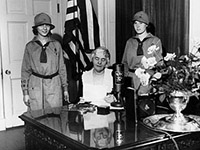


 Mother's Day—as celebrated now in America and in many places abroad—is largely the result of the efforts of a West Virginia woman named Anna Jarvis. In 1908, Jarvis wanted to commemorate her recently deceased mother's own attempt to establish a day in which to honor women.
Mother's Day—as celebrated now in America and in many places abroad—is largely the result of the efforts of a West Virginia woman named Anna Jarvis. In 1908, Jarvis wanted to commemorate her recently deceased mother's own attempt to establish a day in which to honor women.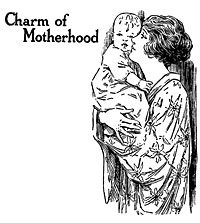
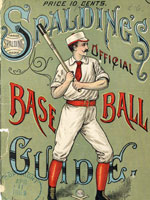

 2 hours. The manual advises, "After having mastered the form of the step, practise it at any convenient opportunity, though it is much better to have a specified hour each day. Two hours per day is little enough if the student is ambitious of excellence."
2 hours. The manual advises, "After having mastered the form of the step, practise it at any convenient opportunity, though it is much better to have a specified hour each day. Two hours per day is little enough if the student is ambitious of excellence." Open Position; Yale Position
Open Position; Yale Position 